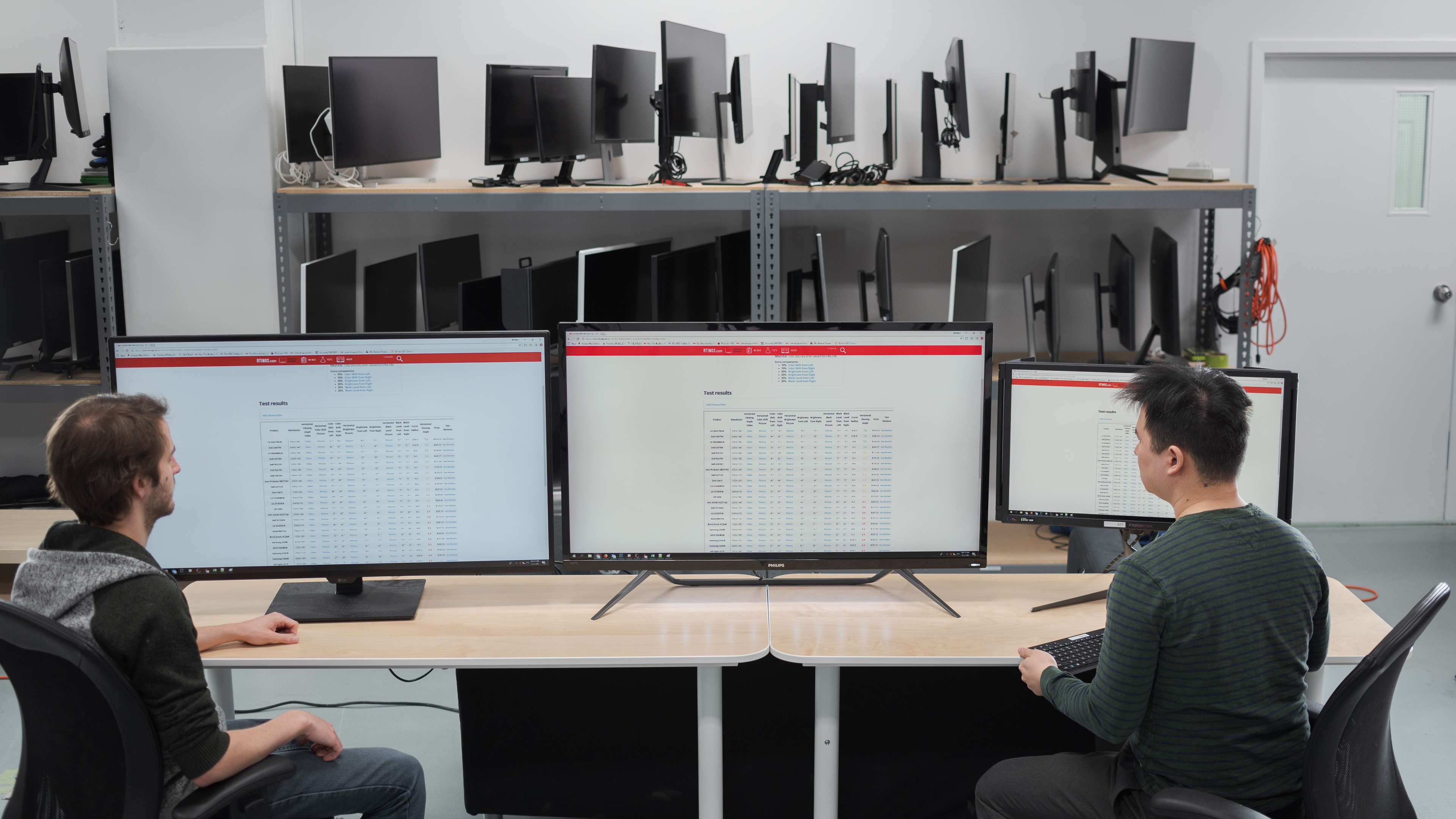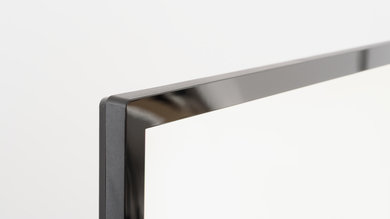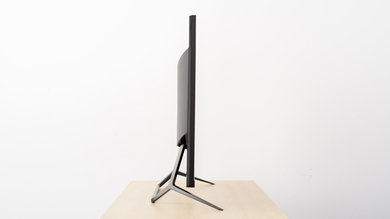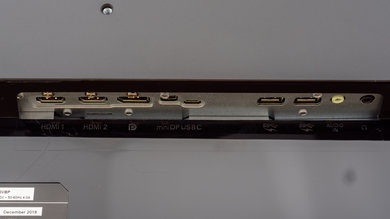Our Verdict
The Philips Momentum 436M6VBPAB is a decent monitor for most uses. It's ideally suited for watching videos with its deep blacks, large screen, 4k resolution, and the added remote is a nice bonus. It could also be a good choice for console gaming with its low input lag, but the 60Hz refresh rate might be limiting for some computer gamers. Unfortunately, there's noticeable crosshatching, due to the strange subpixel structure, so it might not be well-suited for office use.
- Deep, uniform blacks.
- Outstanding peak brightness.
- Great wide color gamut.
- Bad local dimming.
- Noticeable crosshatching that can be distracting for desktop use.
The Philips Momentum 436M6VBPAB is an alright office monitor. The 4k, 43 inch screen is great for multitasking. Unfortunately, it has terrible ergonomics and there's noticeable crosshatching, especially in areas of uniform color, that may be distracting for office use. However, it can get bright enough to combat glare in most office environments, and it displays a wide range of colors with an excellent color gamut.
The Philips Momentum 436M6VBPAB is an okay monitor for gaming. It has excellent low input lag, an okay response time, and supports FreeSync to reduce screen tearing, which is great for console gaming. The built-in USB ports are useful for keeping your controllers charged. The 60Hz refresh rate might be too limiting for some gamers, but the 43 inch screen provides an immersive gaming experience.
Good for multimedia. The Philips Momentum 436M6VBPAB comes with a remote and with its large 4k display, it's a decent alternative to buying a TV. It has an incredible peak brightness, wide color gamut in both SDR and HDR content, and exceptional contrast ratio. Unfortunately, the image degrades when viewed at an angle, so it isn't ideal for watching movies with a few friends.
The Philips Momentum 436M6VBPAB is a good monitor for media creation. The high resolution and large screen allow you to see more of your work without scrolling around or zooming. Unfortunately, it has terrible ergonomics and sub-par viewing angles, and there's noticeable crosshatching in most content, which makes text less clear and could be distracting.
The Philips Momentum 436M6VBPAB is a decent monitor for HDR gaming. It has an excellent native contrast ratio, outstanding peak brightness, and can display a wide color gamut, so HDR games look their best. Unfortunately, the local dimming feature is bad and may be distracting. It also has low input lag and okay response time, although motion is still blurry.
Changelog
- Updated Jan 20, 2021: For consistency, we've changed the height adjustment from N/A to '0.0' and the swivel adjustment from N/A to 'No'. The score has been adjusted accordingly.
- Updated Sep 08, 2020: Validated our results.
- Updated Feb 17, 2020: Converted to Test Bench 1.1.
- Updated May 17, 2019: Review published.
Check Price
Differences Between Sizes And Variants
We tested the 43 inch Philips Momentum 436M6VBPAB, which is the only size available in this series.
If someone comes across a different type of panel or if their Momentum 436M6VBPAB doesn't correspond to our review, let us know and we will update the review. Note that some tests such as the gray uniformity may vary between individual units.
Update 05/21/2019: Some older versions of this monitor have only 1 HDMI port, and may be limited to DisplayPort 1.2.
| Model | Size | Resolution | Refresh Rate | Notes |
| 436M6VBPAB | 43" | 4k | 60Hz | FreeSync |
The 436M6VBPAB we reviewed was manufactured in December 2018.
Popular Monitor Comparisons

The Philips Momentum 436M6VBPAB is a decent 43 inch monitor, but there are better monitors for less. Smaller OLED TVs, like the LG 48 C1 OLED and the LG 48 CX OLED are popular options if you're looking for a large monitor, or if you want a newer model with a similar form factor, the Gigabyte AORUS FV43U. See our recommendations for the best 4k monitors, the best 4k gaming monitors, and the best 34-49 inch monitors.
The Gigabyte AORUS FV43U is better than the Philips Momentum 436M6VBPAB overall, and it's much better for gaming. The Gigabyte has a much faster refresh rate, a faster response time at the max refresh rate, and has an optional black frame insertion feature. The Philips can tilt, whereas the Gigabyte has a completely fixed stand, but both models require a mounting arm if ergonomics are important to you.
The BenQ EW3270U is a bit better than the Philips 436M6VBPAB. The BenQ has slightly better viewing angles and better reflection handling. The Philips is much brighter and has a faster response time.
Despite the difference in panel technologies, the LG 27UK650-W is much better than the Philips 436M6VBPAB. The 27UK650-W uses an IPS panel, which has much better viewing angles and much better gray uniformity. The 27UK650-W also has a more versatile stand with better ergonomics. The Philips uses a VA panel, so it looks much better in a dark room and delivers a better HDR experience than the 27UK650-W.
Although they use different panel technologies, the Acer Predator X27 bmiphzx is significantly better than the Philips 436M6VBPAB for most uses. The X27 uses an IPS panel, and the image remains accurate when viewed at an angle. The X27 also has a faster refresh rate, great for gaming, and has a more versatile stand with better ergonomics. The Acer X27 also has a much better local dimming feature with hundreds of local dimming zones, compared to a few dozen on the Philips. The Philips 436M6VBPAB has a VA panel, and looks much better in a dark room thanks to the much better contrast ratio.

We buy and test more than 30 monitors each year, with units that we buy completely on our own, without any cherry-picked units or samples. We put a lot into each unbiased, straight-to-the-point review, and there's a whole process from purchasing to publishing, involving multiple teams and people. We do more than just use the monitor for a week; we use specialized and custom tools to measure various aspects with objective data-based results. We also consider multiple factors before making any recommendations, including the monitor's cost, its performance against the competition, and whether or not it's easy to find.
Test Results

Update 01/20/2021: For consistency, we've changed the height adjustment from N/A to '0.0'. We've also changed the swivel adjustment from N/A to 'No'. The score has been adjusted accordingly.
The Philips 436M6VBPAB has bad ergonomics. The stand has a narrow tilt range, and can't swivel, adjust its height, or rotate to portrait orientation.
The back of the monitor is very plain. There's no cable management and there's no quick release to remove the stand either.
Exceptional contrast ratio, better than most other monitors. When viewed in dark rooms, blacks appear as they should.
Note: Local dimming is only available in HDR, so we weren't able to test the contrast ratio in SDR with local dimming enabled.
The Philips Momentum 436M6VBPAB has a local dimming feature, but it's bad. It's edge-lit from top and bottom and has a limited number of dimming zones. When a bright object moves quickly across the screen, the local dimming zones aren't able to keep up, causing a glowing trail behind it. The local dimming feature is only available in HDR and, unfortunately, it can't be disabled.
Outstanding SDR peak brightness and it can get brighter than most other monitors. It can get bright enough to combat glare in most rooms, and the brightness is consistent with different content, which is great.
Outstanding peak brightness. It can bring out highlights and vivid colors in HDR. There's no variation in brightness with different content, but it can't get as bright as the Acer Predator X27.
We measured the HDR Peak Brightness with the 'VESA HDR1000' HDR mode. When the monitor is first turned on or the HDR mode is changed, the peak brightness of the 'UHDA' and 'VESA HDR1000' HDR modes is initially much higher, between 1019 and 1100 cd/m². After 2 minutes, the brightness drops off to the posted numbers, and the monitor will never go back to that brightness unless you turn the monitor off or change HDR modes. We're only showing the lower numbers here because the monitor isn't usable for any length of time at the higher brightness.
The 'Normal' HDR mode doesn't do this, and remains at a constant brightness, slightly lower than the other two modes.
As is the case with most VA panel monitors, the horizontal viewing angles are sub-par. You lose image accuracy if you're looking at the screen from the side. If you want a 43 inch monitor with good viewing angles, check out the LG 43UD79-B.
Disappointing vertical viewing angles, which is expected from a VA monitor. The edges of the screen are darker if you sit up close and you lose image accuracy if the Momentum 436M6VBPAB is mounted above or below eye level.
Decent black uniformity on the Momentum 436M6VBPAB. There's some clouding throughout but it shouldn't be very noticeable with most dark content.
Note: We weren't able to measure the black uniformity with local dimming in SDR, as local dimming is only available in HDR.
Disappointing out-of-box color accuracy. Most colors are inaccurate, and with a color temperature warmer than the 6500K target, colors are closer to red/yellow. Shades of gray are also inaccurate, and although the gamma follows the target well, dark scenes appear darker than they should, and bright scenes are brighter.
After calibration, the Momentum 436M6VBPAB has excellent accuracy. Gamma follows the target curve almost perfectly, and the color temperature is much closer to the target of 6500K. Most people shouldn't notice any issues.
You can download our ICC profile calibration here. This is provided for reference only and should not be used, as the calibration values vary per individual unit even for the same model due to manufacturing tolerances.
Incredible color volume in SDR, similar to the Acer Predator X27. Like most LED displays, it can't produce very bright blues.
Impressive HDR color gamut. The Momentum 436M6VBPAB displays a wide color gamut, which is important for HDR content. It also has good coverage of the wider Rec. 2020 color space.
| Overdrive Setting | Response Time Chart | Response Time Tables | Motion Blur Photo |
| Off | Chart | Table | Photo |
| Fast | Chart | Table | Photo |
| Faster | Chart | Table | Photo |
| Fastest | Chart | Table | Photo |
Okay response time, which is limited by the 60Hz refresh rate. The best Overdrive setting is 'Off'. It produces the least amount of overshoot as the other settings, but motion is still blurry. The Overdrive setting is called Smart Response. If you're looking for a similar monitor with better motion handling, check out the Gigabyte AORUS FV43U instead.
This monitor doesn't have an optional black frame insertion feature.
The Momentum 436M6VBPAB supports FreeSync, even when connected to a recent NVIDIA graphics card with a DisplayPort cable. The limited 60Hz refresh rate may disappoint more serious gamers. If you want a 4k monitor with a higher refresh rate, look into the Acer Nitro XV282K KVbmiipruzx.
The Philips 436M6VBPAB has excellent low input lag. To get the lowest input lag, the Low Input Lag setting has to be enabled. Once enabled, this automatically sets the SmartSize setting to 'Panel Size,' and it isn't possible to change the monitor's upscaling or lock it to a fixed aspect ratio.
The Momentum 436M6VBPAB has a fantastic 43 inch screen with a 4k resolution, making it a great choice for watching TV or gaming.
Unfortunately, there's a noticeable crosshatching pattern in some content, and red fringing on the edges of text, as shown here. Tuning the 'ClearType' setting on your PC fixes the fringing on text, as shown here, but doesn't fix the other issues. Philips officially recommends turning ClearType off on your PC, but we didn't find this to help much (shown here with ClearType off).
There is also subpixel dimming that causes shadows to display as the wrong color (original) in some games, similar to the TCL S517. This may be caused entirely by the strange BGR sub-pixel structure, but we don't know for sure.
Depending on how close you're sitting to the monitor, your usage, and your sensitivity to these kinds of issues, this might be distracting.
Update 05/21/2019: Some older versions of this monitor only have one HDMI port.
This monitor has a good selection of inputs, including 2 USB 3.0 ports. The USB-C port can be used as an upstream port to connect to your PC, and according to the manual, supports DisplayPort Alt mode, but we didn't test this.
The Philips 436M6VBPAB has a few additional features, including Philips' unique Ambiglow bias lighting feature. The Ambiglow feature is supposed to light up bias lighting strips along the bottom of the monitor that match the approximate color of the nearest pixels, but in our testing we found the effect to be very subtle, and very slow to react to changing scenes.
The monitor also supports both Picture-in-Picture and Picture-by-Picture, great for multitasking.


















































